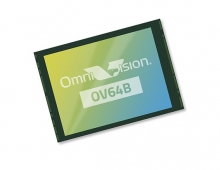
OmniVision's New 5-Megapixel CMOS Sensor to Rival CCDs in High-End Camera Market
OmniVision Technologies (Nasdaq:OVTI introduced the world's first small-scale, CMOS image sensor with 5 megapixels, the OV5610.
The OV5610 delivers the image quality of more expensive charge coupled devices (CCDs), and is expected to measurably reduce the cost of high-resolution digital still cameras (DSCs).
The OV5610's new architecture is based on OmniVision's recently launched OmniPixel(TM) technology. The sensor's 2.775-micron pixels allowed OmniVision to design its 5-megapixel device with an optical format (footprint) of just 1/1.8", making the OV5610 small enough to meet the increasing demand for smaller, low-cost cameras with high performance.
"The OV5610 comes at the right time because by 2005 the largest segment of consumer DSCs is expected to be in the 5-megapixel category, accounting for approximately 35 percent of the market," said Jason Liu, product manager at OmniVision. According to a March 2004 research report from Japanese market research firm Techno Systems Research (TSR), worldwide sales of digital still cameras will reach 64 million units this year and surpass 76 million units in 2005.
To date, the high-end DSC market has been dominated by more expensive CCDs because CMOS sensors have been unable to match CCDs in resolution and image quality. According to Liu, CMOS sensors lead the lower-end segment of the DSC market because of cost effectiveness, but steady improvements in CMOS image sensors are expected to challenge CCDs in the high-end DSC market.
"OmniVision's new proprietary pixel structure diminishes dark current to unnoticeable levels, a key factor in bringing CMOS image quality to CCD levels," said Liu. "In addition, our OmniPixel technology significantly improves the light sensitivity of the sensor, resulting in a higher signal-to-noise ratio -- meaning the camera will perform better in low-light situations. All this adds up to better performance at lower cost."
OmniPixel Opens New Markets For CMOS Sensors: Digital Camcorders and Hybrids
According to a survey done by In-Stat/MDR, a leading market research firm, digital camcorders are second in popularity to DSCs. Survey results also indicate that the majority of digital camcorder owners take still images with their camcorders.
To date, CMOS image sensors have not had the technical capability to compete in the digital camcorder market; CCDs have dominated this entire market segment. OmniPixel technology aims to change this and give CMOS sensors a strong foothold in the digital camcorder and hybrid (digital still and video combined) markets. The highly integrated OV5610, which includes an on-chip 10-bit A/D converter, can perform continuous digital zoom and in VGA resolution is capable of operating at 30 frames per second (fps), making it the ideal candidate for low-cost digital camcorders and hybrid cameras, which combine real digital video and still images in one device.
Until now, still images from digital camcorders have not reached the quality of DSCs, and DSCs have not been able to offer digital video capture other than short clips. "However, combined with already existing back-end digital signal processing (DSP) technology, consumers can now have one compact camera that can both take high-quality pictures and record real video," Liu added. "This opens up a whole new market in the consumer space and, we believe, offers great potential for our OmniPixel product family."
Market Overview: CMOS Catching Up
"The total image-sensor market will grow more than 30 percent annually in unit terms through 2008," said Brian O'Rourke, senior analyst at high-tech market research firm In-Stat/MDR. "With increased performance and a lower cost point, CMOS image sensors are expected to grow at roughly seven times the rate of CCD sensors through 2008, enabling CMOS sensors to surpass CCDs for the first time in 2005. This growth is largely driven by camera phones and low-end DSCs."
"Today's research data does not take CMOS sensors into account when it comes to the digital camcorder and hybrid camera market," Liu continued. "This market is now dominated by CCDs because, until today, CMOS sensors have not had the required technical capability. However, we believe this new product changes these market dynamics, which means that CMOS sensor markets may grow even faster than previously expected. OmniVision is currently working with several key customers in the U.S. and Taiwan to incorporate the OV5610 in new products."
In-Stat/MDR indicates that in addition to new purchasers, more than 25 percent of current DSC owners intend to buy another camera within the next 12 months. "Many consumers face the choice between a DSC and a camcorder, and," said Liu, "if the price is right, a hybrid seems like the logical solution."
Product Datasheet Overview:
The OV5610 is in 1/1.8" optical format and CLCC package. It incorporates a 2592 x 1944 image array and an on-chip 10-bit A/D converter capable of operating at up to 4 fps in full resolution (QSXGA). OmniVision's sensor technology utilizes advanced algorithms to cancel fixed pattern noise (FPN), eliminate smearing, drastically reduce blooming and virtually eliminate dark current. The control registers allow for flexible control of timing, polarity and operation, which, in turn, allow the engineer a great deal of freedom in product design.
The OV5610 is currently in engineering samples with key customers. Production volumes are expected to be available in November 2004, with the first 5-megapixel cameras expected in stores as early as December.
The OV5610's new architecture is based on OmniVision's recently launched OmniPixel(TM) technology. The sensor's 2.775-micron pixels allowed OmniVision to design its 5-megapixel device with an optical format (footprint) of just 1/1.8", making the OV5610 small enough to meet the increasing demand for smaller, low-cost cameras with high performance.
"The OV5610 comes at the right time because by 2005 the largest segment of consumer DSCs is expected to be in the 5-megapixel category, accounting for approximately 35 percent of the market," said Jason Liu, product manager at OmniVision. According to a March 2004 research report from Japanese market research firm Techno Systems Research (TSR), worldwide sales of digital still cameras will reach 64 million units this year and surpass 76 million units in 2005.
To date, the high-end DSC market has been dominated by more expensive CCDs because CMOS sensors have been unable to match CCDs in resolution and image quality. According to Liu, CMOS sensors lead the lower-end segment of the DSC market because of cost effectiveness, but steady improvements in CMOS image sensors are expected to challenge CCDs in the high-end DSC market.
"OmniVision's new proprietary pixel structure diminishes dark current to unnoticeable levels, a key factor in bringing CMOS image quality to CCD levels," said Liu. "In addition, our OmniPixel technology significantly improves the light sensitivity of the sensor, resulting in a higher signal-to-noise ratio -- meaning the camera will perform better in low-light situations. All this adds up to better performance at lower cost."
OmniPixel Opens New Markets For CMOS Sensors: Digital Camcorders and Hybrids
According to a survey done by In-Stat/MDR, a leading market research firm, digital camcorders are second in popularity to DSCs. Survey results also indicate that the majority of digital camcorder owners take still images with their camcorders.
To date, CMOS image sensors have not had the technical capability to compete in the digital camcorder market; CCDs have dominated this entire market segment. OmniPixel technology aims to change this and give CMOS sensors a strong foothold in the digital camcorder and hybrid (digital still and video combined) markets. The highly integrated OV5610, which includes an on-chip 10-bit A/D converter, can perform continuous digital zoom and in VGA resolution is capable of operating at 30 frames per second (fps), making it the ideal candidate for low-cost digital camcorders and hybrid cameras, which combine real digital video and still images in one device.
Until now, still images from digital camcorders have not reached the quality of DSCs, and DSCs have not been able to offer digital video capture other than short clips. "However, combined with already existing back-end digital signal processing (DSP) technology, consumers can now have one compact camera that can both take high-quality pictures and record real video," Liu added. "This opens up a whole new market in the consumer space and, we believe, offers great potential for our OmniPixel product family."
Market Overview: CMOS Catching Up
"The total image-sensor market will grow more than 30 percent annually in unit terms through 2008," said Brian O'Rourke, senior analyst at high-tech market research firm In-Stat/MDR. "With increased performance and a lower cost point, CMOS image sensors are expected to grow at roughly seven times the rate of CCD sensors through 2008, enabling CMOS sensors to surpass CCDs for the first time in 2005. This growth is largely driven by camera phones and low-end DSCs."
"Today's research data does not take CMOS sensors into account when it comes to the digital camcorder and hybrid camera market," Liu continued. "This market is now dominated by CCDs because, until today, CMOS sensors have not had the required technical capability. However, we believe this new product changes these market dynamics, which means that CMOS sensor markets may grow even faster than previously expected. OmniVision is currently working with several key customers in the U.S. and Taiwan to incorporate the OV5610 in new products."
In-Stat/MDR indicates that in addition to new purchasers, more than 25 percent of current DSC owners intend to buy another camera within the next 12 months. "Many consumers face the choice between a DSC and a camcorder, and," said Liu, "if the price is right, a hybrid seems like the logical solution."
Product Datasheet Overview:
The OV5610 is in 1/1.8" optical format and CLCC package. It incorporates a 2592 x 1944 image array and an on-chip 10-bit A/D converter capable of operating at up to 4 fps in full resolution (QSXGA). OmniVision's sensor technology utilizes advanced algorithms to cancel fixed pattern noise (FPN), eliminate smearing, drastically reduce blooming and virtually eliminate dark current. The control registers allow for flexible control of timing, polarity and operation, which, in turn, allow the engineer a great deal of freedom in product design.
The OV5610 is currently in engineering samples with key customers. Production volumes are expected to be available in November 2004, with the first 5-megapixel cameras expected in stores as early as December.

















